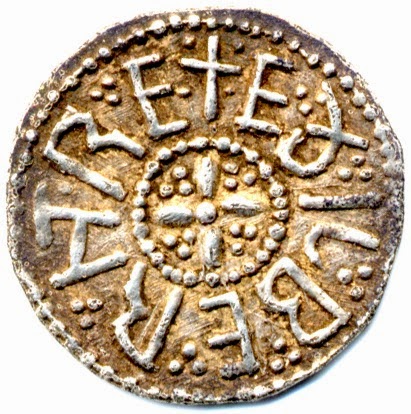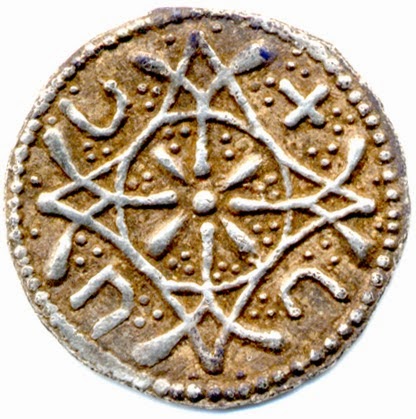Medieval History
Dr Rory Naismith writes:


The three pennies of Æthelberht known before this find all carry a well-known design showing the king?s bust on one face and a wolf and twins on the other, recalling Romulus and Remus, the twins responsible for the founding of Rome, but possibly also playing on the name of the traditional East Anglian royal dynasty, the Wuffingas(?Wolfings?). This new coin carries a completely new design of elegant cruciform motifs on both obverse and reverse, as was common on the coins of other contemporary rulers, not least Offa. It demonstrates effectively how even one new coin might modify understanding of a poorly known ruler. In this case, the new coin indicates that Æthelberht?s coinage was more diverse than had previously been supposed, and that not all his coins carried such symbolically charged iconography. They emerge as something more than a special one-off issue to call attention to the king?s status. That said, Æthelberht apparently only ever had one moneyer ? a man named Lul ? working for him, whereas Offa had several at any one time in the same (or a nearby) mint-place in East Anglia. Æthelberht?s coinage was a relatively small enterprise, and its relationship to Offa?s own coinage remains unclear. Its proclamation of a rival king?s royal status surely would not have gone unnoticed by Offa. On the other hand, Æthelberht?s execution in 794 was only the final stage in their interactions: things may not always have been so antagonistic, and a comparatively diverse coinage for Æthelberht perhaps points to toleration on Offa?s part, conceivably over a period of several years. Further clarification can only come from further new coin-finds.
- Viking Hoard Discovered In England
In what is being described as a ?very exciting find? over 200 items dating back to around the year 900 have been discovered near Silverdale, in north Lancashire. Now known as the Silverdale Viking Hoard, the collection cotnains a total of 201 silver objects...
- Roman Coin Hoards Discovered In Shropshire And Worcestershire
Britain?s Portable Antiquities Scheme announced this week details about two recent discoveries of Roman coin hoards. One involved the find of more than 9000 coins that was discovered in August 2009 by a novice metal detector user in the Shrewsbury area....
- Byzantine And Armenian Coins Acquired By Princeton University
Princeton University has made an important acquisition of ancient and medieval coins from Byzantium and Armenia, including a rare seventh century Byzantine coin that bears the image of Jesus Christ. The Byzantine coin was issued by Emperor Justinian II...
- Arab Coin Dating Back To The Year 805 Found In Norway
Archaeologists in Norway say an ancient Islamic coin dating back to 805 AD was found just west of Oslo earlier this year. Houshang Khazaei, who is a researcher at the University of Oslo, said that the coin is an issue of Abbasid Caliph Harun al-Rashid,...
- Michael Hendy, Byzantinist, Obituary
The Times carried an obituary on 12 June 2008 for our late Fellow Michael Hendy (1942?2008), economic historian and expert on the coinage of Byzantium, who died of a heart attack on 13 May 2008, aged 66, from which the following extracts are taken. ?Michael...
Medieval History
Important new Anglo-Saxon coin
Dr Rory Naismith writes:
Later in June 2014, an important Anglo-Saxon coinis due to be sold at auction by Dix, Noonan and Webb in London. It was discovered in March this year by a metal-detector user who promptly brought his find to the Fitzwilliam Museum in Cambridge for identification. There, it was quickly identified as the fourth known penny of Æthelberht II, king of the East Angles: a ruler who was executed by order of Offa, king of the Mercians (757?96), in 794, and who went on to be the object of veneration as a saint. It was also included in the Corpus of Early Medieval coin-finds.
- Viking Hoard Discovered In England
In what is being described as a ?very exciting find? over 200 items dating back to around the year 900 have been discovered near Silverdale, in north Lancashire. Now known as the Silverdale Viking Hoard, the collection cotnains a total of 201 silver objects...
- Roman Coin Hoards Discovered In Shropshire And Worcestershire
Britain?s Portable Antiquities Scheme announced this week details about two recent discoveries of Roman coin hoards. One involved the find of more than 9000 coins that was discovered in August 2009 by a novice metal detector user in the Shrewsbury area....
- Byzantine And Armenian Coins Acquired By Princeton University
Princeton University has made an important acquisition of ancient and medieval coins from Byzantium and Armenia, including a rare seventh century Byzantine coin that bears the image of Jesus Christ. The Byzantine coin was issued by Emperor Justinian II...
- Arab Coin Dating Back To The Year 805 Found In Norway
Archaeologists in Norway say an ancient Islamic coin dating back to 805 AD was found just west of Oslo earlier this year. Houshang Khazaei, who is a researcher at the University of Oslo, said that the coin is an issue of Abbasid Caliph Harun al-Rashid,...
- Michael Hendy, Byzantinist, Obituary
The Times carried an obituary on 12 June 2008 for our late Fellow Michael Hendy (1942?2008), economic historian and expert on the coinage of Byzantium, who died of a heart attack on 13 May 2008, aged 66, from which the following extracts are taken. ?Michael...
